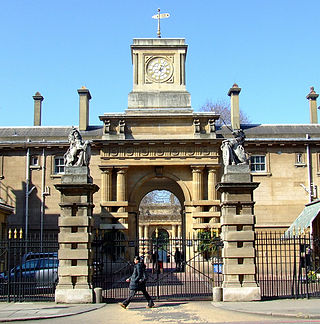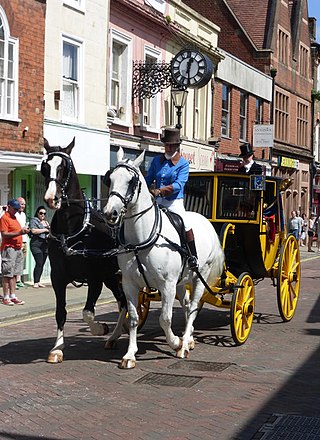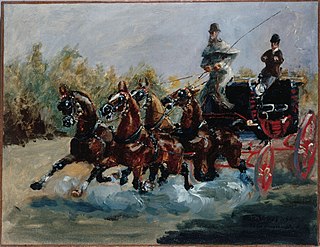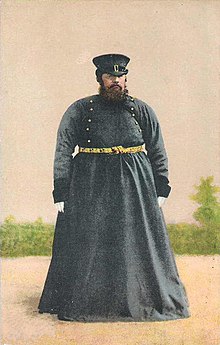
A coach is a type of bus built for longer-distance service, in contrast to transit buses that are typically used within a single metropolitan region. Often used for touring, intercity, and international bus service, coaches are also used for private charter for various purposes. Coaches are also related and fall under a specific category/type of RVs.

A stagecoach is a four-wheeled public transport coach used to carry paying passengers and light packages on journeys long enough to need a change of horses. It is strongly sprung and generally drawn by four horses although some versions are drawn by six horses.

A carriage is a private four-wheeled vehicle for people and is most commonly horse-drawn. Second-hand private carriages were common public transport, the equivalent of modern cars used as taxis. Carriage suspensions are by leather strapping or, on those made in recent centuries, steel springs. Two-wheeled carriages are informal and usually owner-driven.

A chauffeur is a person employed to drive a passenger motor vehicle, especially a luxury vehicle such as a large sedan or a limousine.

The Royal Mews is a mews, or collection of equestrian stables, of the British royal family. In London these stables and stable-hands' quarters have occupied two main sites in turn, being located at first on the north side of Charing Cross, and then within the grounds of Buckingham Palace.

A hackney or hackney carriage is a carriage or car for hire. A hackney of a more expensive or high class was called a remise. A symbol of London and Britain, the black taxi is a common sight on the streets of the UK. The hackney carriages carry a roof sign TAXI that can be illuminated to indicate their availability for passengers.
There are many types of car body styles. They vary depending on intended use, market position, location, and the era they were made.

The Dullahan, also called Colainn Gan Cheann, is a type of legendary creature in Irish folklore. He is depicted as a headless rider, on a black horse, who carries his own head held high in his hand or under his arm.

A phaeton was a form of sporty open carriage popular in the late eighteenth and early nineteenth century. Drawn by one or two horses, a phaeton typically featured a minimal very lightly sprung body atop four extravagantly large wheels. With open seating, it was both fast and dangerous, giving rise to its name, drawn from the mythical Phaëthon, son of Helios, who nearly set the Earth on fire while attempting to drive the chariot of the Sun.

A curricle was a smart, light, two-wheeled chaise or "chariot", large enough for the driver and a passenger and—most unusually for a vehicle with a single axle—usually drawn by a carefully matched pair of horses. It was popular in the early 19th century; its name—from the Latin curriculum, meaning "running", "racecourse" or "chariot"—is the equivalent of a "runabout", and it was a rig suitable for a smart young man who liked to drive himself, at a canter. The French adopted the English-sounding term carrick for such vehicles. The lightweight swept body with just the lightest dashboard hung with a pair of lamps was hung from a pair of outsized swan-neck leaf springs at the rear. For a grand show in the Bois de Boulogne or along the seafront at Honfleur, two liveried mounted grooms might follow.

A post-chaise is a fast carriage for traveling post built in the 18th and early 19th centuries. It usually had a closed body on four wheels, sat two to four persons, and was drawn by two or four horses.

A gig, also called chair or chaise, is a light, two-wheeled sprung cart pulled by one horse.

A horse-drawn vehicle is a piece of equipment pulled by one or more horses. These vehicles typically have two or four wheels and were used to carry passengers or a load. They were once common worldwide, but they have mostly been replaced by automobiles and other forms of self-propelled transport but are still in use today.

A postilion or postillion is a person who guides a horse-drawn coach or post chaise while mounted on the horse or one of a pair of horses. By contrast, a coachman controls the horses from the vehicle itself.

Kocs is a village in Komárom-Esztergom county, Hungary. It lies west of Tata and 65 km (40 mi) north-west of Budapest. A site of horse-drawn vehicle manufacture from the 1400s, the name is the source of the word coach and its equivalent in other languages such as: Czech kočár, Slovak koč, German Kutsche, Dutch koets, Catalan cotxe, Italian cocchio, Spanish, Portuguese, and French coche, Scandinavian kusk, and Serbian кочија (kočija).

Carriage driving is a form of competitive horse driving in harness in which larger two- or four-wheeled carriages are pulled by a single horse, a pair, tandem or a four-in-hand team. Prince Philip, Duke of Edinburgh helped to expand the sport. He started to compete in carriage driving in 1971, and the early rule book was drafted under his supervision.

A coach is a large, closed, four-wheeled, passenger-carrying vehicle or carriage usually drawn by two or more horses controlled by a coachman, a postilion, or both. A coach has doors in its sides and a front and a back seat inside. The driver has a raised seat in front of the carriage to allow better vision. It is often called a box, box seat, or coach box. There are many of types of coaches depending on the vehicle's purpose.

Leopold Lojka was the chauffeur of the car carrying Austro-Hungarian Archduke Franz Ferdinand at the time of Ferdinand's assassination in Sarajevo in 1914.

The Lord Mayor of London's State Coach is, along with the King's Gold State Coach and the Speaker's State Coach, one of the three great State Coaches of the United Kingdom. Unlike the other two the Lord Mayor's Coach is used annually at the Lord Mayor's Show, and as such it is deemed to be the oldest ceremonial vehicle in regular use in the world.

Kutsche, with numerous other spellings, is a German surname with several etymologies, including one Hungarian and several Slavic.
























